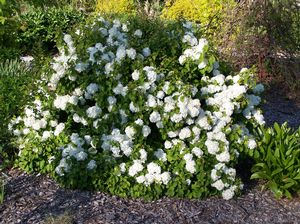Printed at http://www.quackingrassnursery.com/index.cfm/
Viburnum plicatum f. tomentosum 'Newport'
Japanese Snowball Viburnum
Plant Type:
DECIDUOUS SHRUBSViburnum plicatum f. tomentosum ‘Newport’ – Japanese Snowball Viburnum is well known and deservedly so; this one, not so much… We hope to change that status. This had been originally sold to us with the moniker 'Nanum'. It had come from the now defunct Environmentals Nursery. It should not be confused with 'Nanum Semperflorens' (a.k.a. 'Watanabe') which grows taller, less dense and produces lace cap flowers. May flowers are rounded popcorn cymes which surprisingly are fertile as this shrub does set some late season red berries – not many, but some. (Many dwarf and miniature plants are trapped in “genetic juvenility” and are, therefore, sterile – incapable of fruiting. Tom Ward, formerly of Arnold Arboretum shared this factoid with us.) Fall color has consistently been a bronze-red or red-purple, very nice with other woody plants that sport yellow, orange and bright red autumn tones. Our specimen was about 4’ tall at its center in 9 years before we had to remove it because it had outgrown it designated spot. It grew so densely that low-nesting birds have consistently enjoyed its cover and have successfully raised brood after brood through the years. Yes, we will find another spot or two or even three for Viburnum plicatum ‘Nanum’! In its new location it grew to 7 feet in approsximately 10 years. Viburnums as a general rule attract butterflies; the berries feed the birds.
In 2022 Gary Ladman shared with us that he believes 'Nanum' is actually a cultivar called 'Newport'. We think the nomenclature issue is now resolved; that 'Nanum' which we acquired from Environmentals on Cutchogue, LI some 22 years ago is actually 'Newport'. This dense growing intro was made by Lake County Nursery in Perry, Ohio. Gary - thank you!
Characteristics and Attributes for Viburnum plicatum f. tomentosum 'Newport'
Season of Interest (Flowering)
- Spring
Season of Interest (Foliage)
- Spring / Summer / Autumn
Autumn Interest
- Autumn Leaf Color
Nature Attraction
- Deer Resistant
- Songbirds
- Honey Bees & Native Bees
Light
- Full Sun
- Mostly Sunny
Attributes
- Hedge
- Border
- Hedgerow
- Foundation
- Rock Garden
- Wildlife Garden
- Shrub Border
Growth Rate in the Garden
- Slow
Soil
- Fertile
Origins
- Garden Origin
Propagated By
- Cutting Grown
Genus Overview: Viburnum
Common Name: Viburnum
Viburnum. This genus is full of fantastic, multi-season garden worthy shrubs. Garden heroes. Spring flowers, often large and showy, many with heady sweet fragrance are arranged in cymes. Some smell of musk (Viburnum dilatatum) while others produce no fragrance at all. Flowers are followed with berries. If late season and autumn berries are desired then planting two of a species will ensure fruit set; for instance, Viburnum dilatatum 'Erie' and V. dilatatum 'Michael Dodge' will pollinate each other and produce fruit. Viburnum cassinoides is closely allied with V. nudum; but if the flowering times do not overlap then there will be no fruit. However, if you plant V. nudum 'Winterthur' in proximity with V. nudum var. angustifolium, 'Longwood', 'Moonshine' or 'Pink Beauty' berries will abound. Another interesting example is V. lantana which crosses with V. burejaeticum and vice versa. Any V. plicatum f. tomentosum selection such as 'Shasta' or 'Shoshoni' will pollinate with all other V. plicatum f. tomentosum selections like 'Copper Ridges or 'Pink Beauty'. But if you were to plant two 'Shasta' side by side with no other V. plicatum f. tomentosum in near proximity then your effort will be fruitless. As with almost all in the universe of plants there are exceptions. There is one viburnum which appears to be self-fruitful, Viburnum setigerum the Tea Viburnum. Another interesting exception to the rule is Viburnum nudum 'Pink Beauty' which is also self-fruitful - a departure from its siblings. And on the other spectrum are two I can think of off-hand that are barren, Viburnum plicatum 'Roseum' and Viburnum plicatum 'Kern's Pink'. Oftentimes, the dwarf viburnums reamin in a juvenile state and do not produce fruit. All Viburnum of any size that do produce fruit are magnificent in the late season garden. And they feed all manner of birds. Larger, denser shrubs provide cover and nesting opportunities. Nearly all Viburnum have terrific autumn foliage colors, too. Viburnums are members of Caprifoliaceae. All prefer part to full sun and fertile soils. All are cutting grown. Many thanks to Gary Ladman of Classic Viburnums who generously set us straight regarding some of the details we had originally incorrectly lauded... ya can't know everything!



